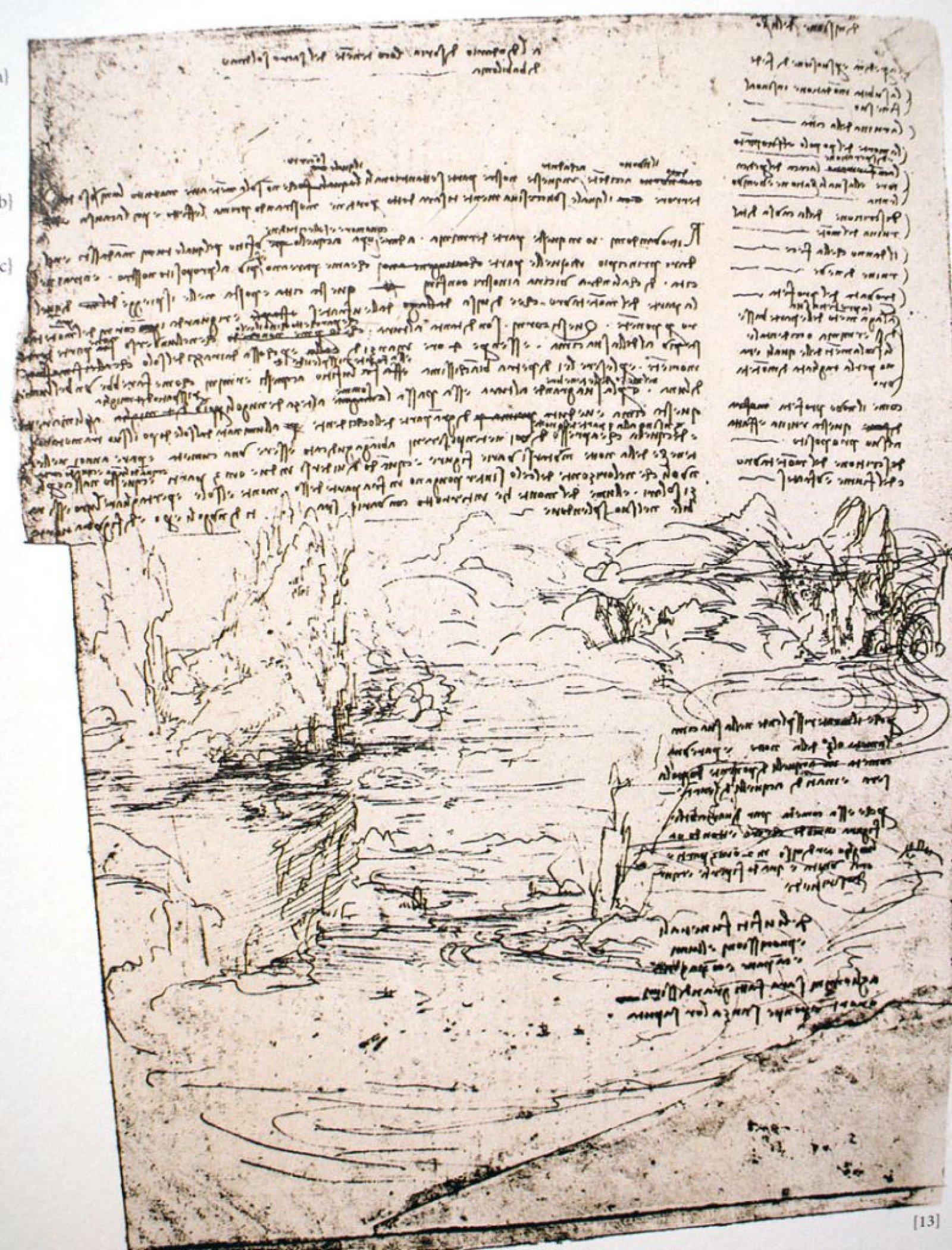LEONARDO DA VİNCİ TOROSLARDA / LEONARDO DA VINCI AT THE TAURUS MOUNTAINS
02.09.2019
Leonardo Da Vinci az sayıda eser bırakmakla beraber, kendisinden geriye çok sayıda eskiz ve not kalmıştır. Sayıları 9 bine ulaştığı söylenen bu notları sadece resim değil, mühendislik, matematik, jeoloji, anatomi gibi bilim ve sanatın değişik alanlarında bilgiler içerir. Yeni icatlar, genç ressamlara notlar, sipariş aldığı işlerle ilgili hazırlık ve görüşler bulunur.
İşte bu notlar dikkatle incelendiğinde, XVI. Yüzyılda Mersin, Adana, Antakya bölgesinin bağlı olduğu Halep Vilayeti defterdarından Toros Dağlarında görülen sel baskınlarına çare bulması için iş teklifi aldığı ve bu nedenle gemiyle o zamanki ismi Calindra olan Aydıncık’a geldiği görülmektedir.

Da Vinci defterlerinde Orta Torosların özelliklerini anlatmakta ve coğrafi konumunu belirtmektedir.
Babil’in kutsal sultanının vekili, Suriye Defterdarına diye başladığı metinde, Calindra şehrinin Toros Dağları eteklerinde yer aldığını yazdıktan sonra Toros Dağları zirvelerini şöyle tarif eder;
“Bu zirveler öyle yüksektir ki, gökyüzüne ulaşacakmış gibi görünürler. Dünyanın hiçbir noktasında bu zirvelerden daha yüksek bir yer yoktur. Güneş ışınları gün doğumundan 4 saat önce dağın doğusuna düşer.. Yüksekliği ile düz bir hat boyunca dört millik bir yer kaplayan en yüksek bulutların seviyesine erişir. Gün batımından sonra da güneşin gecenin üçte biri kadar aydınlattığı bu zirve batıya doğru pek çok yerden görülebilir”

Diğer bir mektubunda da Toros Dağlarının Biçimi Üzerine ve Toros Dağının Yapısı ile Büyüklüğü Üzerine isimli 2 görüş yazısı bulunmaktadır. Bu yazılarda önce işi yavaştan aldığı için defterdardan özür dilemekte, ardından Toros Dağlarının yapısını anlatmaktadır;
“Toros Dağlarının başka dağlarla birlikte Kafkas Dağlarının temelini oluşturduğu söylenir. (...) Haziran ayı ortalarında güneşin geldiği belli noktada Toros Dağının gölgesi öyle bir yüksekliğe ulaşır ki bu gölge on iki günlük mesafedeki Sarmatya (Kafkasya) sınırlarını; Aralık ayı ortasında ise kuzeye doğru bir aylık mesafedeki Hiperborya (Sibirya) sınırlarını bulur. (...) Bu dağın özellikle de güneye bakan, bol ürünün alınabildiği, çok güzel su kaynaklarının ve nehirlerin bulunduğu eteklerinde zengin bir halk yaşar. Üç mil kadar yukarı çıkınca büyük köknar, kayın ve buna benzer ağaçların bulunduğu ormanlara ulaşırız. Bu ormanlardan üç mil sonra ise geniş ovalar ve otlak alanlar gelir. Geri kalanı ise hiç bir zaman erimeyen uçsuz bucaksız kardır.”
Görüldüğü gibi yazıda Leonardo’nun bazen masala kaçan coşkusu var olsa da o yıllarda Torosların Da Vinci’nin bile dikkatine girmesi ilginçtir.
Ayrıca üstat o yıllarda bir Türkiye haritası da çizmiştir. Gerçeğe oldukça yaklaştığı haritasında Da Vinci; Marmara Denizi’ni atlayarak, iki boğazı kanal gibi gösterirken, Seyhan ve Ceyhan Nehirlerini de İskenderun Körfezi’ne dökülen tek bir nehir olarak çizmiş. Ancak tek nehir olarak çizmesine rağmen üzerine hem Adana, hem de Misis köprülerini işaretlemiş.

LEONARDO DA VINCI AT THE TAURUS MOUNTAINS
Although Leonardo da Vinci left few works, many sketches and notes remained after him. His notes which are said to be consisting of nearly 9 thousand pages contain knowledge not only about painting but also about sciences such as engineering, mathematics, geology, and anatomy. There are also new inventions, notes for young artists and preparations and views about the works for which he received orders in these notes.
When these notes were studied carefully, it could be seen that he got an offer from the provincial treasurer of the then Ottoman province of Aleppo where the cities of Mersin, Adana, and Antakya and their environs were connected. He got an offer to find a solution for the floods seen in the region of the Taurus Mountains and came to Aydıncık whose name was Calindra then by a ship.
Da Vinci writes about the characteristics of the Central Taurus Mountains in his notebooks and states their geographical position.
The deputy of the sacred Sultan of Babel describes the peaks of the Taurus Mountains after he writes that the city of Calindra is at the foothills of the Taurus Mountains in the texts he starts with the title ‘'To the Provincial Treasurer of Syria'':
‘'These peaks are so high that they look as if they will touch the sky. There is no point higher than these peaks at any point in the World. Sun rays fall to the east of the mountains 4 hours before the sunrise. They reach the level of the highest clouds which occupy a place of four miles at least with their height. This peak which is lightened by the sun at a level one-third of the night after the sunset can be seen from many places towards the West.

In another letter of his, there are two articles written by him named ‘'On the Shape of the Taurus Mountains'' and ‘'On the Structure and Size of the Taurus Mountains.'' In these articles, he apologizes to the provincial treasurer for his slowness and then tells about the structure of the Taurus Mountains;
‘'The Taurus Mountains are said to make the base of the Caucasus together with other mountains. (…) The shadow of the Taurus Mountains reaches such a high point that this shadow reaches the borders of Sarmatia (Caucasia) which are at a distance of twelve days and the borders of Hyberborea (Siberia) which are at a distance of one month. (…) A very rich folk live at these mountains' foothills especially facing the south where plenty of harvests can be taken and very beautiful spring sources and rivers exist. When we go up for about three miles, we reach forests where great fir, beech, and similar trees are found. Three miles after these forests, there are wide plains and pastures. The rest is immense snow which never melts.''
As it is seen, although there is the sometimes fabulous enthusiasm of Leonardo da Vinci in the article, it is interesting that the Taurus Mountains attracted his attention in those years.
 9646
9646







 BEYRUT; ORTADOĞU'DA BİR PARİS
24.12.2018 tarihinde yayınlandı ve 5843 kez okundu.
BEYRUT; ORTADOĞU'DA BİR PARİS
24.12.2018 tarihinde yayınlandı ve 5843 kez okundu.






Yorum yap